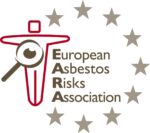
What is abestos, where you can find it, types of asbestos products and materials that contain it, what are fibers and what are the effects on health..
One of ARPAT‘s managers of Tuscany, dr. Gabriele Fornaciai,during a training session for technical staff, talked about a particular pollution substance, asbestos, which is often to the attention of citizens.
The following is a summary of his speech with a few purely technical additions for a better understanding.
What is asbestos
Asbestos is a mineral, and is therefore a natural product extracted from the earth’s crust.
A silicate with a fibrous structure, which consists of bundles of very fine fibers parallel to each other. A fiber is a particle elongated in a preferred direction.
Types of asbestos
Asbestos can be found in nature in two different mineralogical morphologies (shape) and chemical compositions:
– Serpentine, whose main variety is called Chrysotile white asbestos, a silicate of magnesium (Mg);
– Amphibole Asbestos, whose best-known varieties are: Amosite or brown asbestos, Crocidolite or blue asbestos, tremolite and anthophyllite.
They are all silicates of iron (Fe), magnesium (Mg), calcium (Ca) and manganese (Mn).
– Chrysotile has a sinusoidal structure: the fibers tend to curl.
– The amphiboles have a needle structure: the fibers tend to be straight. For example, amosite and crocidolite are difficult to distinguish by morphology, but only for the respectively brown and blue colours.
Where was extracted
In Italy a Chrysotile mine was active in Balangero (Piemonte), now closed and under clean up.
Chrysotile is mined today in Canada and in many other countries. The amphibole is extracted in South Africa, Russia, South America, China, where hundreds of millions of tons have been extracted in 30 years and more.
Properties
Properties have been known since ancient times. Asbestos may be loomed and yarned all at once or mixed with other materials, and is easily processable. Has a low cost, and has been used for many properties that characterize it: is non-combustible, is an excellent insulating, sound-absorbing, resistant to acids and bases.
Utilization
It is used in various sectors of industry and construction.
For example textiles (ropes); gas industry and water, electricity and steel industry (seals), means of transportand in particular shipbuilding (seals, sprayed, linings); construction (cement, panels, linoleum).
There are more than 3000 known products:
asbestos cement (flat and corrugated roofing sheets, pipes and water boxes, chimneys, prefabricated panels – can become brittle with time and wear); vinilasbestos (was used for floors of buildings – schools and hospitals – in the form of tiles. Compact material); friction materials (gaskets, brakes, clutches) precast panels (ships and trains), cards, boxes, seals (thermal insulation of pipes and tanks for hot fluids, boiler plants, heating systems, fireproof overalls, textile industry); lanyards (for welding), ropes, fabrics (thermal insulation); spray material(metals, cement, wood. It is the most dangerous because the more brittle. Used for fire protection and noise).
For their capacity to disperse fibers in the air they are divided in friable and compact. A material is called friable if it can be reduced to powder just with simple finger pressure.
Asbestos and health
Asbestos has been classified by IARC (International Agency for Research on Cancer) WHO (World Health Organization) as a carcinogen (category 1) if inhaled.
There are currently no epidemiological evidences proving the occurrence of asbestos-related diseases for the ingestion of asbestos fibers.
Aerodynamic behavior and effects on the persons
The penetration of the fibers in the human body occurs through the respiratory system. The fibers are the more dangerous the more they are fine: they are breathable.
Definition of normed breathable fibers
Normed breathable fibers have a diameter less than 3 microns, and length greater than 5 microns, length / diameter ratio greater than 3:1. [1 mm (micron) = 1 millionth of a meter].
The aerodynamic shape can influence the breathability.
Behavior of mechanical action
Asbestos fibers have one longitudinal flaking, that is due to mechanical action: from 1 fiber of one micron in diameter, 2 fibers from 0.5 microns in diameter can be formed, 4 to 0.25 mm, 8 from 0.125 mm, etc.., all with the same length.
Behavior of artificial fibers
The artificial fibers (glass wool) flake parallel to the diameter, although while asbestos fibers remain for long time in lung tissue, artificial ones tend to dissolve by the action of fluids.
